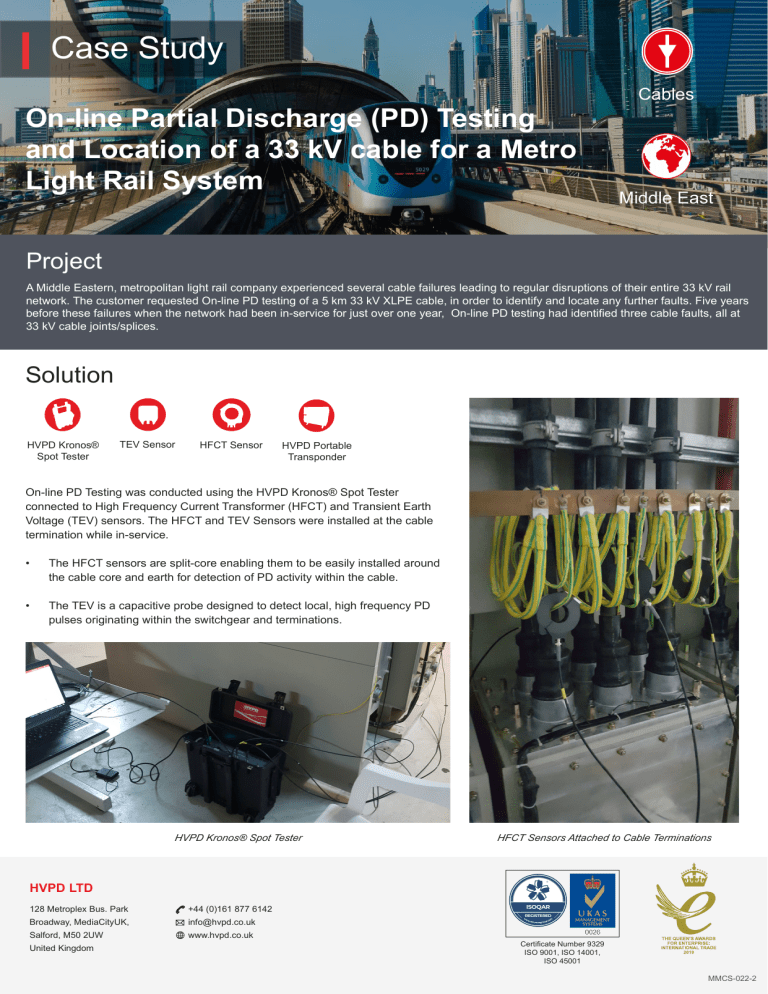On-line PD Testing and Location of a 5 km 33 kV cable for a Metro Light Rail System
advertisement

Case Study On-line Partial Discharge (PD) Testing and Location of a 33 kV cable for a Metro Light Rail System Cables Middle East Project A Middle Eastern, metropolitan light rail company experienced several cable failures leading to regular disruptions of their entire 33 kV rail network. The customer requested On-line PD testing of a 5 km 33 kV XLPE cable, in order to identify and locate any further faults. Five years before these failures when the network had been in-service for just over one year, On-line PD testing had identified three cable faults, all at 33 kV cable joints/splices. Solution HVPD Kronos® Spot Tester TEV Sensor HFCT Sensor HVPD Portable Transponder On-line PD Testing was conducted using the HVPD Kronos® Spot Tester connected to High Frequency Current Transformer (HFCT) and Transient Earth Voltage (TEV) sensors. The HFCT and TEV Sensors were installed at the cable termination while in-service. • The HFCT sensors are split-core enabling them to be easily installed around the cable core and earth for detection of PD activity within the cable. • The TEV is a capacitive probe designed to detect local, high frequency PD pulses originating within the switchgear and terminations. HVPD Kronos® Spot Tester HFCT Sensors Attached to Cable Terminations HVPD LTD 128 Metroplex Bus. Park +44 (0)161 877 6142 Broadway, MediaCityUK, info@hvpd.co.uk Salford, M50 2UW www.hvpd.co.uk United Kingdom Certificate Number 9329 ISO 9001, ISO 14001, ISO 45001 MMCS-022-2 Case Study Background Theory Cable mapping is conducted by detecting the original PD pulse from the fault location as well as a reflected PD pulse (caused when the original PD pulse reaches the far end of the cable). Using the time delta between these pulses, and the signal propagation speed the approximate location of the PD source can be identified. In cables of 5 km and longer, it is often necessary to use an HVPD Portable Transponder at the opposite end of the cable to amplify PD signals, allowing the HVPD Kronos® Spot Tester to receive and interpret the relative arrival times of pulses at each end of the cable to give an accurate location. This is important because when testing from just a single end, PD pulses reflected from the far end of long cable runs can often become difficult to interpret due to large signal attenuation and increased levels of noise. Results High levels of PD were detected and the location was pinpointed to a cable joint, 475 m along the 33 kV cable. The PD trace clearly showed the Direct PD pulse injected, the Reflected PD pulse, and the amplified Transponder pulse. Analysis of the Phase Resolve PD Pattern (PRPD) and PD signals indicated that the PD was likely to be the result of a non-conducting cavity/void within the cable insulation. Direct PD pulse Reflected PD pulse PD Trace Transponder pulse PRPD Pattern Conclusions and Recommendations • Due to high levels of PD detected and located during On-line PD testing, a cable fault was identified to a cable joint, 475 m along the 33 kV cable. If left undetected, this fault would have likely caused another unplanned outage. • The customer purchased an HVPD Kronos® Spot Tester and continues to perform routine On-line PD testing as part of their Condition-Based Maintenance. HVPD LTD 128 Metroplex Bus. Park +44 (0)161 877 6142 Broadway, MediaCityUK, info@hvpd.co.uk Salford, M50 2UW www.hvpd.co.uk United Kingdom Certificate Number 9329 ISO 9001, ISO 14001, ISO 45001 MMCS-022-2



